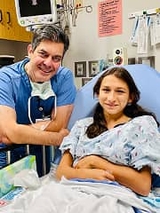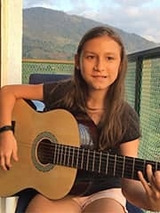Beckwith-Wiedemann Syndrome and Pancreatoblastoma: Kaitlyn’s Story
Beckwith-Wiedemann Syndrome and Pancreatoblastoma: Kaitlyn’s Story
Shortly after Kaitlyn was born, she was diagnosed with a rare genetic disorder. She’s undergone multiple surgeries for many different complications in her 12 years and, recently, needed chemotherapy for an associated cancer. Through it all, “She always had a really good attitude,” says her mother, Claudia. Adds her father, Jorge, “We know she’s going to be very successful.”

When Claudia was pregnant with Kaitlyn, everything seemed fine — until an ultrasound revealed that the placenta “looked like Swiss cheese,” says Jorge. There was no question that they would keep the baby. “We knew our baby would be God’s gift.”
When Kaitlyn was born at 31 weeks, Jorge cut the umbilical cord, and he could see on the nurses’ faces that something was wrong. It was discovered that Kaitlyn’s glucose wasn’t stable and she had cysts on her liver — symptoms of the genetic disorder Beckwith-Wiedemann syndrome (BWS).
Claudia and Jorge brought Kaitlyn to Children's Hospital of Philadelphia (CHOP). “We wanted the best hospital with the most experience,” says Claudia. CHOP has a unique expertise due to the number of patients followed in the Beckwith-Wiedemann Syndrome Clinic led by Jennifer Kalish, MD, PhD, and those followed in the Hyperinsulinism Center led by Diva DeLeon, MD, MSCE. Genetic testing confirmed the BWS diagnosis.
A rare type of Beckwith-Wiedemann syndrome
More About BWS
BWS is caused by changes in genes that control body growth. In Kaitlyn’s case, she has a rare and likely under-diagnosed cause called genome-wide paternal uniparental isodisomy (GWpUPD). Usually, people have two copies of chromosome 11, one inherited from their mother and one from their father, and they balance each other. With paternal uniparental isodisomy, both copies are inherited from the father, and so the growth genes from the father’s chromosome are not counterbalanced by the mother’s. In GWpUPD, all 23 pairs of chromosomes, including chromosome 11, are inherited from the father in some cells of the body.

Kaitlyn spent four months in the Harriet and Ronald Lassin Newborn/Infant Intensive Care Unit for several issues including hyperinsulinism. Once home, the cysts on her liver began filling with liquid — one eventually contained more than a liter of fluid. Kaitlyn’s belly became distended and got in the way of normal infant activity like crawling. Because BWS also causes asymmetric growth, she had limb length discrepancy, which would become more apparent as she got older. Affected children also have an increased risk of developing certain cancers.
When Kaitlyn was 14 months old, Peter Mattei, MD, an attending pediatric surgeon, removed the cysts. Kaitlyn was able to learn to walk, and when she was 3, the family moved to Colombia to be near Claudia’s family.
Dance classes, and then new symptoms
They lived in Colombia for several years, and Kaitlyn did well. The difference in the length of her legs didn’t stop her from developing a love of dance. But eventually, as she got older, the discrepancy worsened, and she also developed masses in her breasts. “When the masses started growing, it reminded us of what she went through with her liver,” says Jorge. They decided CHOP was where they needed to be again.
Almost 10 years after the surgery to remove the liver cysts, Claudia and Jorge were happy to learn that Dr. Mattei would again be Kaitlyn’s surgeon to remove the breast masses. Richard Davidson, MD, a pediatric orthopedic surgeon, performed a procedure to stop the bone growth in her longer leg, so the other leg could catch up.

Due to the increased risk of cancer associated with BWS, especially the type of BWS that she has, her medical team, led by Dr. Kalish, performed imaging, which revealed that Kaitlyn had a pancreatic tumor. The tumor was surgically removed, and because the cancer had spread to her lymph nodes, Kaitlyn started chemotherapy managed by Suzanne MacFarland, MD.
“This was all within two months,” Jorge points out. “Kaitlyn has stayed so tough. And happy. No one would realize she’s going through chemo if it wasn’t for her hair loss. She is a lovely, smart and happy girl!”
At every step, the family has remained steadfast. “Faith is everything, and we put our faith in our Lord and Savior Jesus Christ,” says Claudia. “We know He is in full control. This is a testimony for God’s miracles.” Adds Jorge: “Love is very important, and as a family you must stick together. You can’t play the victim or wonder why this is happening. We smile, laugh and joke constantly.”
Kaitlyn enjoys several hobbies, just like any other kid. She plays guitar, likes to draw and loves cats. Her next goal, once her leg is healed: “I’m going to start learning Irish dancing!” she proclaims.
Donations power clinical and basic science research and development of educational resources through the Beckwith-Wiedemann Syndrome Program. By donating to CHOP, you will make a difference in the lives of children with BWS.